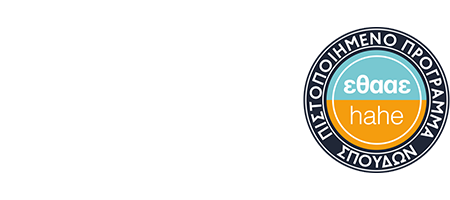COURSE OUTLINE
- GENERAL
| SCHOOL | AGRICULTURAL AND FORESTRY SCIENCE | ||||
| DEPARTMENT | FORESTRY AND MANAGEMENT OF THE ENVIRONMENT AND NATURAL RESOURCES | ||||
| LEVEL OF STUDIES | UNDERGRADUATE (7) | ||||
| COURSE CODE | SEMESTER | 3rd | |||
| COURSE TITLE | METEOROLOGY | ||||
| TEACHING ACTIVITIES in case the ECTS Credits are distributed in distinct parts of the course e.g. lectures, labs etc. If the ECTS Credits are awarded to a course as a whole, then please note down the teaching hours per week and the corresponding ECTS Credits. |
TEACHING HOURS PER WEEK | ECTS CREDITS | |||
| Lectures | 3 | ||||
| Laboratory Practice | 2 | ||||
| Sum | 5 | 5 | |||
| Add lines if necessary. The teaching organization and methods used are described in the point 4. | |||||
| COURSE TYPE
Background, General Knowledge, Scientific Area, Skill Development |
Scientific Area | ||||
| PREREQUISITES:
|
None | ||||
| TEACHING & EXAMINATION LANGUAGE: | Greek | ||||
| COURSE OFFERED TO ERASMUS STUDENTS: | Yes | ||||
| URL COURSE: | https://eclass.duth.gr/courses/OPE02186/ | ||||
- LEARNING OUTCOMES
| Learning Outcomes | |
| Please describe the learning outcomes of the course: Knowledge, skills and abilities acquired after the successful completion of the course. | |
| The course is designed and structured to offer undergraduate students an introduction to the field of Atmospheric Environment and its management. Students will get familiarized with the atmospheric processes that govern the weather and climate. Upon successful completion of the course students will be able to:
· identify and interpret the various meteorological and climate phenomena, · apply the fundamental laws of Physics that govern the atmospheric phenomena, · resolve the fundamental equations of the atmosphere, · read weather maps. |
|
| General Skills | |
| Taking into account the general skills that the graduate must have acquired (as they are listed in the Diploma Supplement and are listed below), which of them is intended (for the course)? | |
| Search, analysis and synthesis of data and information, using the necessary technologies
Adaptation to new situations Decision making Autonomous work Teamwork Working in an international environment Working in an interdisciplinary environment Production of new research ideas |
Project design and management
Equity and Inclusion Respect for the natural environment Sustainability Demonstration of social, professional and moral responsibility and sensitivity to gender issues Critical thinking Promoting free, creative and inductive thinking |
| · Literature search, data analysis and synthesis
· Critical thinking · Working in an interdisciplinary environment · Production of new research ideas · Promoting free, creative and inductive reasoning · Respect for the natural environment.
|
|
- COURSE CONTENT
| 1. Introduction to the Atmospheric Science
2. Composition of the atmosphere 3. Layering of the atmosphere 4. Solar and Terrestrial Radiation (I) 5. Solar and Terrestrial T=Radiation (II) 6. Temperature 7. Atmospheric Pressure 8. Wind 9. Water in the atmosphere: atmospheric humidity parameters, evaporation, transpiration 10. Water in the atmosphere: clouds, small-scale condensation forms, precipitation 11. Atmospheric disturbance: airmasses, fronts 12. Atmospheric disturbance: depressions and anticyclones 13. Atmospheric disturbances: tropical cyclones, storms, waterspouts, tornados. |
- LEARNING & TEACHING METHODS – EVALUATION
| TEACHING METHOD Face to face, Distance learning, etc. |
Face to face | ||||||||||||||||||
| USE OF INFORMATION & COMMUNICATIONS TECHNOLOGY (ICT) Use of ICT in Teaching, in Laboratory Education, in Communication with students |
Power point presentations, videos, e-class platform | ||||||||||||||||||
| TEACHING ORGANIZATION
The way and methods of teaching are described in detail. Lectures, Seminars, Laboratory Exercise, Field Exercise, Bibliographic research & analysis, Tutoring, Internship (Placement), Clinical Exercise, Art Workshop, Interactive learning, Study visits, Study / creation, project, creation, project. Etc.
The student study hours for each learning activity are listed as well as the non-guided study hours so that the total workload at the semester level corresponds to the ECTS standards. |
|
||||||||||||||||||
| Student Evaluation
Description of the evaluation process
Assessment Language, Assessment Methods, Formative or Concluding, Multiple Choice Test, Short Answer Questions, Essay Development Questions, Problem Solving, Written Assignment, Essay / Report, Oral Exam, Public Presentation, Laboratory Report, Clinical examination of a patient, Artistic interpretation, Other/Others
Explicitly defined assessment criteria and if and where are accessible to students are mentioned. |
The evaluation process is conducted in Greek. In case of Erasmus students, the examination language is English. The evaluation process includes:
– Written final examination (essay development and problem solving) – 80% of the final grade – Laboratory exercise in the classroom – 20% of the final grade.
|
- SUGGESTED BIBLIOGRAPHY
| · Εφαρμοσμένη Μετεωρολογία, Ευάγγελος Μπαλτάς, Εκδόσεις ΖΗΤΗ
· Μαθήματα Γεωργικής Μετεωρολογίας και Κλιματολογίας, Αικατερίνη Χρονοπούλου-Σερέλη & Απόστολος Φλόκας, Εκδόσεις ΖΗΤΗ · Μαθήματα Μετεωρολογίας και Κλιματολογίας, Απόστολος Φλόκας, Εκδόσεις ΖΗΤΗ
|
ANNEX OF THE COURSE OUTLINE
Alternative ways of examining a course in emergency situations
| Teacher (full name): | Anastasia Paschalidou |
| Contact details: | By email to apascha@fmenr.duth.gr
or through the e-class platform |
| Supervisors: (1) | – |
| Evaluation methods: (2) | Written examination with distance learning methods (platform e-Class), ensuring the integrity and reliability of the examination. |
| Implementation Instructions: (3) | The students will be given a multiple-choice test consisting of 20 questions. All questions are equal in terms of grading and account for 0,5 units. Wrong answers have negative grading. The duration of the exam is 15 mins. |
- To be completed with YES or NO
- Note down the evaluation methods used by the teacher, e.g.
- written assignment or/and exercises
- written or oral examination with distance learning methods, provided that the integrity and reliability of the examination are ensured.
- In the Implementation Instructions section, the teacher notes down clear instructions to the students:
α) in case of written assignment and / or exercises: the deadline (e.g. the last week of the semester), the means of submitting them to the teacher, the grading system, the participation of the assignment in the final grade and every other detail that should be mentioned.
β) in case of oral examination with distance learning methods: the instructions for conducting the examination (e.g. in groups of X people), the way of pronouncing topics, the applications to be used, the necessary technical means for the implementation of the examination (microphone, camera, word processor, internet connection, communication platform), the way the hyperlink is sent, the duration of the exam, the grading system, the participation of the exam in the final grade, the ways in which the inviolability and reliability of the exam is ensured and every other detail that should be mentioned.
γ) in case of written examination with distance learning methods: the instructions for assigning the topics, the way of submitting the answers, the duration of the exam, the grading system, the participation of the exam in the final grade, the ways in which the integrity and reliability of the exam is ensured and every other detail that should be mentioned.
There should be an attached list with the Student Registration Numbers only of the beneficiaries to participate in the examination.
 Στόχος μας είναι η παροχή των κατάλληλων εργαλείων, σε κάθε μέλος του Τμήματος. Επιλέξτε εδώ για να δείτε τις
Στόχος μας είναι η παροχή των κατάλληλων εργαλείων, σε κάθε μέλος του Τμήματος. Επιλέξτε εδώ για να δείτε τις 
